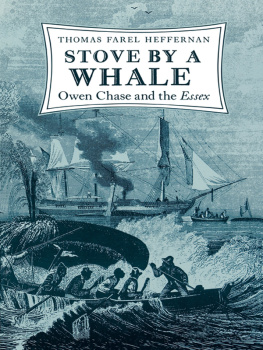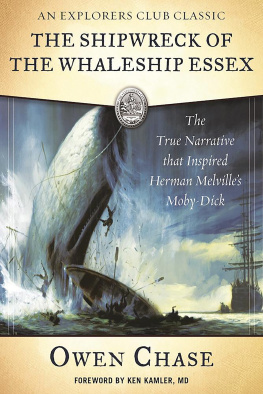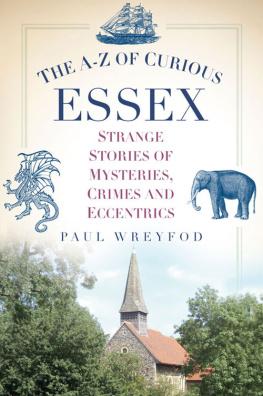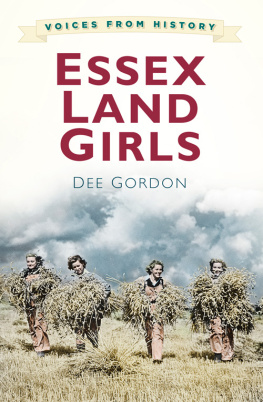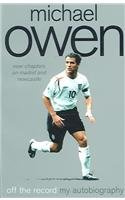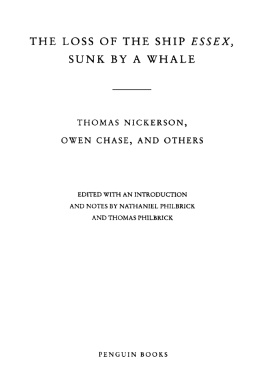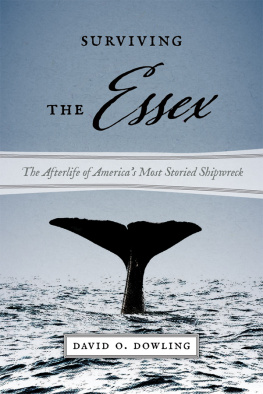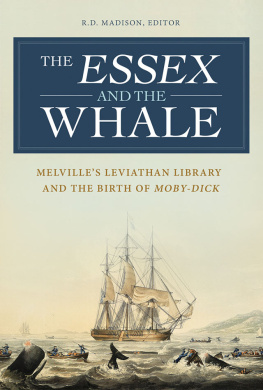
STOVE BY A WHALE
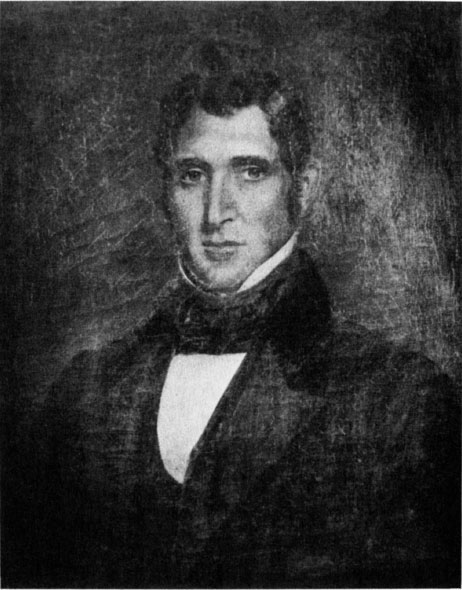
OWEN CHASE
THOMAS FAREL HEFFERNAN

STOVE BY A WHALE
Owen Chase and the Essex
Wesleyan University Press
Middletown, Connecticut
WESLEYAN UNIVERSITY PRESS
Middletown, CT 06459
1981, 1990 by Thomas Farel Heffernan
All rights reserved
Printed in the United States of America
5 4 3
Originally produced in 1990 by
Wesleyan/University Press of New England
Hanover, NH 03755
Library of Congress Cataloging-in-Publication Data
Heffernan, Thomas Farel, 1933
Stove by a whale : Owen Chase and the Essex /
Thomas Farel Heffernan.
p. cm.
Includes bibliographical references and index.
ISBN 0-8195-6244-0
1. Chase, Owen. 2. Essex (Whale-ship). 3. Survival
(after airplane accidents, shipwrecks, etc.). I. Title.
G545.H38 1990
910.45dc20 90-38190

I dont know when I was first in that kitchenit was more than forty years agoand I must have seen the maple chest then, but children dont pay attention to things like that. Children want to go out into the fields and find hedgerow blackberries and snakes. But my wife saw it the first time she was in the kitchen. Oh, Irene Chase said, that was Howards great-grandfathers sea chest. Sea chest? I said, not Owen Chases? No, it was Owens brothers. But that was enough; the vessel had been rubbed and the genie came out, hardly waiting to be asked to tell the following story, which therefore demands to be dedicated to the people of the chestto Carol and to Howard and Irene Chase and to Isabell Chase Burnett.
CONTENTS
ILLUSTRATIONS
Owen Chase
By permission of Isabelle and Margaret Tice; reproduced by the Peter Foulger Museum from a photograph in its collection frontispiece
Title page of the first edition of Owen Chases Narrative
By permission of the Princeton University Library
Map of the Essex adventure
Commodore Charles Goodwin Ridgely
By permission of Mary Kent Norton; photographed courtesy of the Frick Art Reference Library
U.S.S. Constellation around the time of Owen Chases rescue
Courtesy of the Naval Photographic Center, Naval District, Washington, D.C.
Capt. Thomas Raine
By permission of Maxwell Raine
Lydia Chase Tice, daughter of Owen Chase, and her husband,
Capt. William Harvey Tice
By permission of Isabelle and Margaret Tice
Capt. Joseph Chase
By permission of Isabelle Chase Burnett
Herman Melvilles annotations of Owen Chases Narrative
By permission of the Houghton Library, Harvard University.
Owen Chases descent from William Chase
Owen Chases marriages and children
PREFACE
In 1819 a Nantucket whaleship put to sea for a voyage from which it never returned. Almost two years later a handful of its officers and crew set foot again on Nantucket with a story that would distinguish their Essex from the countless other whaling ships that had gone to the bottom of the worlds wide oceans. For something had happened to the Essex that had never happened to any ship before: it had been attacked and sunk by a whale.
The story of the Essex belongs especially to its first mate, Owen Chase, who became the historian of the disaster. Within a few months of the Essex survivors return to Nantucket, a New York publisher brought out a thin volume under Owen Chases name that told the story of the Essex and its crew. Herman Melville tells us how he came to read the book. The Acushnet, on which Melville had sailed from Fairhaven on his first whaling voyage, had gammed an unidentified Nantucket ship:
In the forecastle I made the acquaintance of a fine lad of sixteen or thereabouts, a son of Owen Chace. I questioned him concerning his fathers adventure; and when I left his ship to return again the next morning (for the two vessels were to sail in company for a few days) he went to his chest & handed me a complete copy of the Narrative. This was the first printed account of it I had ever seen, The reading of this wondrous story upon the landless sea, & close to the very latitude of the shipwreck had a surprising effect on me.
When Melville turned to the writing of Moby-Dick, the little book that William Henry Chase had lent him at sea was to provide the ending of the novel. In chapter 45 of Moby-Dick Melville again spoke of Owen Chase and quoted from Owens book some passages that are awesome enough in themselves but become more awesome in Melvilles eerily reverential reference to them.
From some familiar and many new sources the story of Owen Chase and the Essex has been collected in the book that follows. At the appropriate point in the book the teller will become Owen Chase himself: his Narrative of the Most Extraordinary and Distressing Shipwreck of the Whale-ship Essex is a vivid and compelling account into which not a touch of quaintness has crept in a century and a half. It is the indispensable document on the Essex.
This study is indebted to so many people that I could not dedicate a page apiece to them. My very first thanks go to Owen Chases collateral descendants, Mr. and Mrs. Howard Chase, Aurora, New York, and Mrs. Isabell Chase Burnett, Ithaca, New York. I would not even have started on this book without the documents, information, and encouragement they lent to the undertaking. Owen Chases great-great-granddaughters, Isabelle and Margaret Tice, were also most kind and helpful.
Then come the Nantucketers: my debt to Edouard Stackpole, Louise Hussey, Helen Winslow, and Andre Aubuchon, accumulated over many long weeks spent in the Peter Foulger Museum, is massive.
From the descendants of the English captain who rescued three of the Essex survivors from Henderson Island I have received the most generous and painstaking attention to all inquiries: the Honourable E. P. T. Raine, C. B. E., E.D., his aunt Margaret Fane De Salis, and his brother Maxwell Raine.
At the National Archives I have had the help of many of the staff, of whom I must mention Kenneth Hall, Gibson Smith, William F. Sherman, James Harwood, and Terry Matchette; at the Library of Congress I am indebted to John McDonough, Manuscript Historian, and to the staff of the Manuscript Division.
I also thank Wilson Heflin; Louise Coulson; Charles Paddack, M.D.; Charlotte Giffin King; Douglass Fonda; Eugenio Pereira Salas; Patricia Reynolds, La Trobe Librarian, the State Library of Victoria; Suzanne Mourot, Mitchell Librarian, the State Library of New South Wales; D. Troy, Acting Senior Archivist of the Archives Authority of New South Wales; Robert Langdon of the Pacific Manuscripts Bureau; Irene Moran, University of California at Berkeley; Mona L. Dearborn, National Portrait Gallery; Bruce Barnes, formerly of the New Bedford Free Public Library; Marion V. Bell, Enoch Pratt Free Library; V. J. Kite, Avon County Library Service; G. D. Harraway, Office of the Governor of Pitcairn Island; the Earl of Dundonald; Mrs. Leroy T. Taylor; Mrs. Mary K. Norton; the late Chester Simkin; Mr. and Mrs. Ray Lewis; Carlos Lopez; Sonia Pinto Vallejos; Franklin Proud; Eduardo Reyes; Mr. and Mrs. Archibald Davies; Nicholas Carbo; Suzanne M. Zobel; William Omeltchenko; J. Stephen Taylor; Rollo G. Silver, Claude L. Chappell; John Tebbel; Mr. and Mrs. John Donahue; Frank Muhly and Bunny Harvey; and three experts on a chemical question: Richard Rapp, Rutgers University; G. H. Lording, the British Phosphate Commissioners; and Arthur Notholt, Institute of Geological Sciences (London).
Next page
